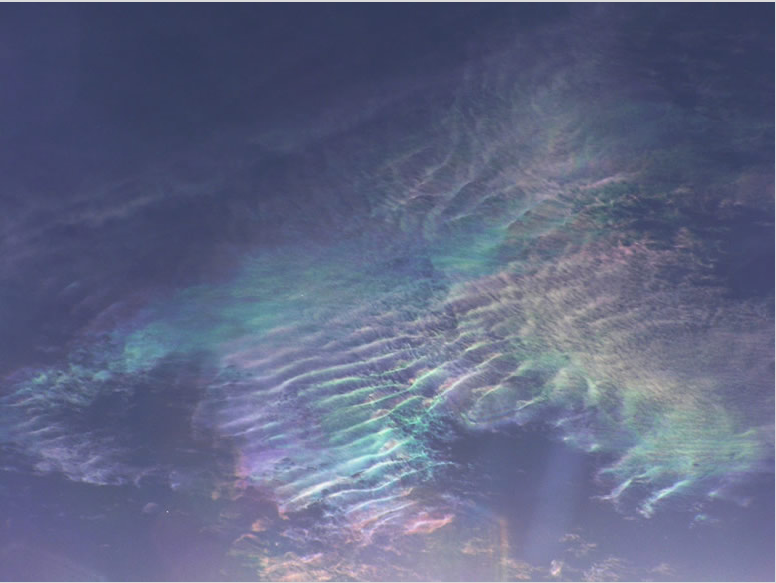Iridescent Clouds
Iridescent Clouds: Nature's Colorful Display
Have you ever looked up at the sky and noticed clouds that seem to shimmer and glow with vibrant colors? These mesmerizing phenomena are known as iridescent clouds. While clouds are typically seen as white or gray, iridescence adds a whole new dimension to their appearance, creating a captivating display of colors. In this article, we will delve into the fascinating world of iridescent clouds, exploring what causes them, where they can be seen, and the science behind their stunning hues.
What Causes Iridescent Clouds?
Iridescent clouds owe their enchanting colors to a phenomenon called cloud iridescence. This optical effect occurs when sunlight interacts with tiny water droplets or ice crystals within the clouds. As sunlight passes through these particles, it undergoes diffraction, scattering, and interference. This complex interplay of light results in the separation of colors and the creation of iridescent patterns.
The Role of Water Droplets and Ice Crystals
Both water droplets and ice crystals play a crucial role in the formation of iridescent clouds. When light encounters these microscopic particles, it is bent, refracted, and diffracted, causing the different wavelengths of light to separate. This separation gives rise to the vivid hues seen in iridescent clouds, ranging from pinks and purples to greens and blues.
Atmospheric Conditions and Cloud Types
Iridescent clouds can form in various types of clouds, including altocumulus, cirrocumulus, and lenticular clouds. These cloud types often have a layered or wavy appearance, providing the ideal conditions for the diffraction and scattering of light. Additionally, iridescent clouds are more commonly observed when the sun is low on the horizon, such as during sunrise or sunset. The angle of the sunlight enhances the interaction with the cloud particles, intensifying the iridescent effect.
Geographic Distribution
Iridescent clouds can be observed in different parts of the world, although their occurrence is relatively rare. They are more commonly seen in regions with a high concentration of water droplets or ice crystals in the atmosphere. Areas with frequent cloud formations, such as mountainous regions, coastal areas, and places with a humid climate, are more likely to experience these stunning displays of iridescence.
The Colors of Iridescent Clouds
The colors exhibited by iridescent clouds are a result of the diffraction and interference of light waves. As light passes through the water droplets or ice crystals, it is split into its component colors, similar to how light passes through a prism. The size and shape of the particles determine which colors are most prominently displayed. Smaller particles tend to create shorter wavelengths, resulting in hues like blues and violets. Larger particles, on the other hand, produce longer wavelengths, leading to colors such as reds and oranges.
Capturing the Beauty of Iridescent Clouds
Photographers and sky enthusiasts often seek out iridescent clouds to capture their ethereal beauty. To photograph these stunning displays, it is best to use a polarizing filter on the camera lens. This filter helps to enhance the contrast and saturation of the colors, allowing for a more vivid representation of the iridescence. Patience and timing are also key, as iridescent clouds are transient and may only last for a few minutes or even seconds.
Similar Atmospheric Optical Phenomena
While iridescent clouds are captivating in their own right, they are not the only atmospheric optical phenomena that grace our skies. Other related phenomena include:
- Rainbow: A familiar sight after rainfall, rainbows form when sunlight is refracted, reflected, and dispersed by water droplets in the air.
- Halos: These luminous rings encircling the sun or moon are created by the refraction and reflection of light in ice crystals.
- Glory: A circular ring of colors surrounding the shadow of an observer, glories occur when light is backscattered by water droplets or small ice crystals.
The Science of Atmospheric Optics
The study of atmospheric optics delves into the intricate mechanisms behind the interaction of light with atmospheric particles. Scientists and researchers utilize advanced instruments and computer models to better understand the formation and behavior of these optical phenomena. By studying iridescent clouds and other atmospheric displays, they gain valuable insights into the composition and properties of the Earth's atmosphere.
Appreciating the Wonders Above
Iridescent clouds serve as a reminder of the beauty and complexity of the natural world. Their ever-changing colors and ethereal appearance inspire awe and wonder in those fortunate enough to witness them. So, next time you find yourself gazing at the sky, keep an eye out for these breathtaking displays of iridescence. Who knows what other marvels may await, just waiting to be discovered amidst the vast expanse above us?

Shannon Story saw these wonderfully structured iridescent clouds at Weatherford, Texas on Dec 4, 2005. Another image.
Image ©Shannon Story, shown with permission.
Note: this article has been automatically converted from the old site and may not appear as intended. You can find the original article here.
Reference Atmospheric Optics
If you use any of the definitions, information, or data presented on Atmospheric Optics, please copy the link or reference below to properly credit us as the reference source. Thank you!
-
<a href="https://atoptics.co.uk/blog/iridescent-clouds-7/">Iridescent Clouds</a>
-
"Iridescent Clouds". Atmospheric Optics. Accessed on April 18, 2024. https://atoptics.co.uk/blog/iridescent-clouds-7/.
-
"Iridescent Clouds". Atmospheric Optics, https://atoptics.co.uk/blog/iridescent-clouds-7/. Accessed 18 April, 2024
-
Iridescent Clouds. Atmospheric Optics. Retrieved from https://atoptics.co.uk/blog/iridescent-clouds-7/.